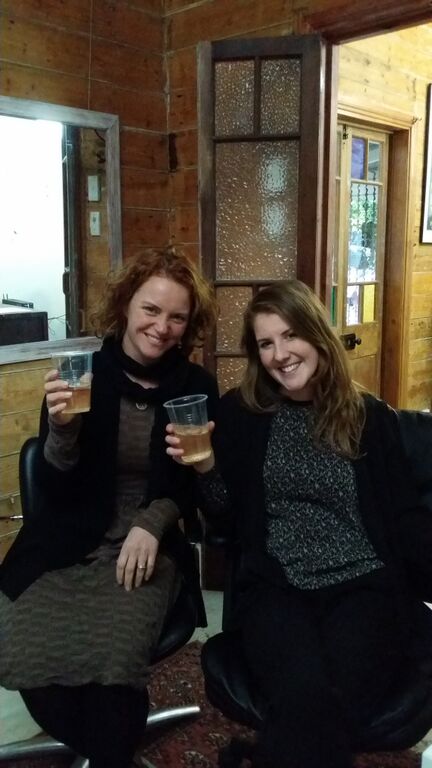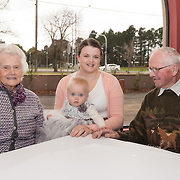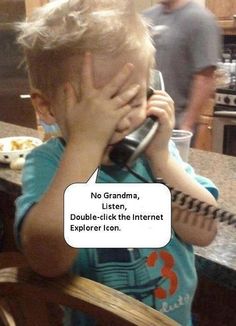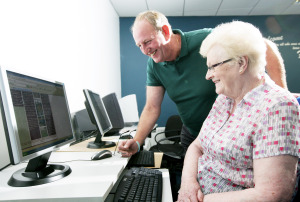The post Can your clients see your website? appeared first on Agility Communications.
]]>Here’s a quick summary of some of the age-related vision changes arriving from upper middle age (50+) onward:
• loss of focusing ability, especially close up, due to hardening of the lens inside the eye (presbyopia)
• pupils become less responsive to changes in ambient lighting (hence the need for brighter lighting for comfortable reading)
• loss of peripheral vision, meaning over the years the peripheral visual field shrinks up to 20-30 degrees by the 70’s and 80’s
• decreased colour vision, meaning colours are less bright, the contrast between colours is less distinct, and people have trouble distinguishing between different colours, such as between dark blue and brown or blue from green or purple
• increased sensitivity to glare – seeing clearly in reflected light or bright sunlight is more difficult
• changes in the time it takes to adjust to differences in light levels, say, between bright and dark areas – it can take two to three times longer than at an earlier age
• depth perception becomes more difficult – judging the height of a kerb or a step is harder, and shadowy areas may be misinterpreted
Some of these natural changes can be corrected for, for example, by adding reading glasses for close up focus, increasing ambient light brightness or using sunglasses for times in glare conditions. Others, though, can be responded to by design solutions in websites and other forms of communications.
Website accessibility & design
Tips for the design work to aid website accessibility:
• text size: consider a larger font size (minimum of 12 point) and allow for the reader to enlarge the text; if using lots of text, enable a text-only version as well
• get the contrast right: make the contrast distinct rather than subtle, use bold text to strengthen readability, and allow text highlighting
• choose colours for action items carefully: between colour blindness and loss of colour sensitivity, older readers need further help with clearly distinguishing buttons for action – use clearly visible text and clear icon designs, choosing safe colours for these users
• if you also have a mobile site, allow desktop users a choice to access that too, as mobile sites are usually more visually distinctive
• allow keyboard shortcuts for navigation help (arrow keys and keystrokes to move around a site rather than only following a mouse, which may be indistinct to visually challenged readers)
• use media and audio tools as well on your website, giving another means to access your information
• test your designs with your target audience and use checking tools that are available (colour and contrast tools can identify problem areas within your website)
Lots of us don’t consider ourselves visually impaired, but these age-related vision changes will affect us, even subtly. To reach this large and growing audience effectively, websites just need some simple principles applied for effective design for everyone. If you’d like any help with analysing your website’s effectiveness in these areas, give us a call or an email. Engaging with issues of ageing, disabilities and communications is what Agility does.
The post Can your clients see your website? appeared first on Agility Communications.
]]>The post Researching caregiving for an aging parent appeared first on Agility Communications.
]]>If you are lucky enough to have an incredibly talented and erudite friend and colleague nearby, you engage her to help out. That is what I did with Mary-Faeth Chenery and this is her first blog for me based on her experience of navigating the aged care maze for services for a family member.
Thank you Mary-Faeth
Diving in to build a new program or facet of your work
So it’s time to develop and promote a new program or a new facet of your work – and for that, you need some good, current information to build on. Where to start and how to streamline your information gathering efforts? Here is one approach to help you get started, make headway, and get it done!
I’ll use my recent experience with building a community program around caregiving for an ageing parent to illustrate this approach.
Phrase your new program/direction as a current issue – try expressing it as a question
My ‘problem’ was that I needed to learn about caregiving for an ageing parent – my partner’s dad – and I figured that if I needed this, so might others in the community. So the current issue was ‘Caring for an Ageing Parent’ , or expressed as a question: ‘What do I and others in my situation need to know to care properly for an ageing parent, and how can we find out?’
Generate 5 keywords to guide your information search – the more specific the better
I started out with huge terms: caregiving, aged care, home care, medical needs of the elderly. These were honed to more tailored and specific topics: aged care in Hepburn Shire, transition from hospital to home care, Shire resources to support ageing at home, safety in the home, respite care
Identify 3-5 top sources for reliable, current information – people, organisations, journals, books, websites
I looked first for people who could advise me – the ones already engaged in the topic, who could give me shortcuts to what I needed to know. Found a few organisations – like COTA and Carers Victoria and a few terrific books that would show me the whole territory of my topic and identify the current issues and resources. Naturally, a few websites came into this, like myagedcare.gov.au
Read from 5 sources and interview 3 people about the possibilities
Aside from the reading, probably the best source of information were several local people who had recently gone through the process of caring for an aged parent. So they could tell me what they had learned, the best sources of information, and the hazards of the whole process. This certainly helped tailor the process of planning the program.
Mind-map as you go – write/draw/connect the ideas you are learning about from your information search on a blank page that you can turn into a map of the new program/direction
I am a visual learner, so it helps me to draw out the various elements of what I’m learning about, add concepts, show relationships, summarise ideas, make new connections between ideas. Out of this came a plan of the three key areas to cover in the forum that was emerging as the program design.
Stay wide open: be prepared to – at least temporarily – suspend your present ideas about where you think the program is going
After the first stage of the program (where we held an information forum), one of the planning group members proposed the idea of broadening the program for the next stage – moving from a specific focus on caregiving to the promotion of ‘ageing well’ or ‘positive ageing’, which could include caregiving but took it much further. I had to suspend my preconceived notions of what the program was about and think about what the community needed and wanted. I think the program became better for that. So what started as ‘Stand by Me – An Information Forum on Caregiving’ became ‘Ageing Well in Hepburn Shire’.
Mentally – or with colleagues – test out a possible version of the new program/direction as you gain new information – ‘suppose it looked like this and worked like this – how good would that be? Would it meet the need?’
By this point we had a planning group of about 5 people, and ideas were tested here. Again, the program got better I think.
Ask: where are the gaps?
One of the gaps we identified was that the need for caregiving often comes on quite suddenly – you don’t know you are going to need this information about aged care and caregiving until you need it desperately. Like, your parent with no warning ends up in hospital and is coming home to live with you. So the new program needed to convince people to learn about ageing and caregiving before it was needed. What are the best ways to do that via our program, we wondered.
Plug the gaps with more information searching
We tried to get more and more specific and find those who could really help us with detailed information and strategies around the gaps.
Ask big questions: is this the best we can do to solve the problem? What would we do if we did not have resource limits? If we had our best clients design the program/direction, what would it look like?
For the Ageing Well program, this is probably our next phase: an evaluation that looks at whether there are better approaches, new ideas, innovations to learn from.
Draft the first edition of the program/direction
A plan was sketched out for 12 months of work….
Test out the first edition in discussion with colleagues and friends who will be helpful and honest in their feedback
We have a great planning group – honest and supportive – so the plans have evolved over time, with lots of willingness to change and also to contribute. Couldn’t ask for more.
This process is just one way – but one or two of the ideas just might get you moving toward creating something new and transformative for your work. All the best!
The post Researching caregiving for an aging parent appeared first on Agility Communications.
]]>The post Can’t find your point of difference? Make it diversity. appeared first on Agility Communications.
]]>And let’s face it – everyone loves a celebration. It’s fun, it lifts spirits, it builds connection and community, and it makes us all feel better about who we, and each other, are.
There can be some really simple things you can do in your service to make those celebrations alive a vibrant for your clients. It doesn’t matter whether you have people at your service who identify with the communities that the various International Days commemorate – but of course it’s great if you do and, more likely than not, you will.
Here’s a list of some of the days you might like to think about including in your service’s program of celebrations:
- May 15 International Day of Families
- May 17 International Day against homophobia, bi-phobia and transphobia
- May 21 World Day for Cultural Diversity
- May 27-June 3 National Reconciliation Week (including May 26, National Sorry Day)
- 1 June Global Day of Parents
- 7 June Ramadan begins
- 19-25 June Refugee Week
- 20 June World Refugee Day
- 3-10 July NAIDOC week
- 7 July Eid Al Fitr
A good way to plan for these days is to include your clients in discussions about what might be done. Even planning a celebration can be as much fun, and as strongly building of community, as the celebration itself.
Each of these days celebrate different people, cultures and events. They all generate their own possibilities for something to mark the day. A day that celebrates families and parents, for example, could be celebrated by people sharing photos of their own families, their own children and parents, or telling stories. Your clients’ families could be encouraged to come along and be part of this.
For a day like International Day against homophobia, bi-phobia and transphobia, you could show a film like Priscilla: Queen of the Desert.
On days that celebrate particular cultures, or commemorate important events in their history, such as Sorry Day or the beginning of Ramadan, you could bring into your service a representative of the community being marked by the day, and they could chat with clients about the history of their culture, or even just tell their own personal story as an indigenous person, a Muslim person, and so on. Imagine the stories that could be told about the thousands of years of Aboriginal history of the place at which your service is located! Foods from different cultures could be part of the day, or displays of art and music.
For something like Refugee Week, chances are that there are people using your service who have themselves come from backgrounds where they needed to flee persecution and war. Many will still have memories and stories to share. You could spend a day encouraging them to do this, find pictures and old newspaper clippings about the journeys people have made to Australia, and have them on display throughout your service. Libraries and the Internet can be great sources for this sort of archival material.
All of these celebrations provide you with the opportunity to involve the outside community in your service, too. There are community organisations that are devoted to each of the issues commemorated on these days, and many of them will be more than keen to engage with the people using your service.
The possibilities are endless – and the important thing to do is to try to think what will resonate with and connect to the people who use your service. Even though some of these days are about very serious issues, the day can still be about having fun, sharing yarns, and encouraging respect. It’s a chance to discover, and to rediscover, that, regardless of age, life and communities are full of different histories, different stories, different ways of celebrating what it means to be a person.
Agility can help aged care, health and disability services with planning these sorts of days. We can come and spend time with your staff and talk about strategies you might want to adopt for planning a celebration with your service users in a way that will be meaningful for them, and in which they can be genuinely and meaningfully included. We can also help you to get media to your event to highlight your diversity and ability to connect with community.
No one should miss out on a chance for a party, or simply to sit down and listen to someone else tell an amazing tale about an amazing past.
For more on making your service accessible to a diverse range of people see Are your aged care services inclusive and supportive of your LGBTI clients
The post Can’t find your point of difference? Make it diversity. appeared first on Agility Communications.
]]>The post Are your aged care services inclusive and supportive of your GLBTI clients? appeared first on Agility Communications.
]]>One of the really great things about providing aged care services is that you are supporting one of the richest and most diverse mixes of people in our community. The aged and ageing population is made up of people with long and lively histories, with stories that have been at the core of who we all now are, and with identities that reflect the vibrant mix of people that make up today’s Australia.
While we are all getting much better at recognising and celebrating that diversity, especially in terms of the many cultures, languages and ethnicities that people bring to your services, one group that can often be forgotten in the mix are gay, lesbian, bisexual, transgender and intersex people – or GLBTI people.
The terms can sometimes be hard to grasp, and you may feel they are changing all the time, and even people who themselves identify as members of the GLBTI communities may mean slightly different things when they use these words, or may describe themselves with other words altogether. While this can feel confusing, and you might be unsure about what terms to use and what they mean, it is actually a good thing because it reminds us that people all think and talk about themselves differently, even in relation to their sexuality and gender. When we grasp the value of those differences, and respect them, we have already begun to lay the right foundations to providing services in ways that will make people feel they belong.
The lives and experiences of GLBTI people will be as diverse as the people themselves. Today’s aged and ageing population has grown up through times of considerable change in relation to how issues of sexuality and gender are understood by communities, families, churches, the law and society more broadly. None of this, of course, has affected how many people are GLBTI – there have always been GLBTI people in all walks of life, and across all age groups – but it has affected how those people have thought about themselves, and how easy or difficult it has been for them to live their lives openly amongst their families, colleagues and friends.
So you can be sure that you will have GLBTI people in your service, but you cannot be sure how they will see or feel about this aspect of who they are. Some may have histories of being very open about their GLBTI identity; some may have told no one or very few people; some may just be beginning now to feel good about who they are and to feel like living their life more openly as a GLBTI person; some may still be struggling with all of these issues.
It is important that your service is able to be inclusive and supportive of your GLBTI clients, wherever they might be on this journey. Issues of sexuality and gender identity continue to be immensely important for people as they age – and sometimes even more so, as a decline in independence and loss of skills can intrude upon people’s sense of who they are and of what defines them.
There are many ways that your service can strengthen its inclusiveness of, and support to, your GLBTI clients. One is to consider undergoing Rainbow Tick accreditation. The Rainbow Tick was funded by the Victorian Government Department of Health and was developed by Gay and Lesbian Health Victoria together with Quality Improvement and Community Services Accreditation. It involves both self-assessment and external review, and is based on a set of standards that identify a range of areas and indicators for good practice in meeting the needs of GLBTI clients. A Rainbow Tick can be a great way of showing that you are a service that is committed to including GLBTI people in positive, progressive ways.
You might also like to check out an article about transgender issues in particular, which provides some simple tips about how to be more inclusive of, and how to avoid being offensive towards, your transgender clients. It’s only a start – but it’s a good start and a good way to keep mindful of some of the important issues. It can be surprising how much we don’t think about, when we are used to thinking only in conventional ways about gender and gender identity.
You can also engage the services of Agility to help you think through the issues, to strengthen your communications around GLBTI accessibility and relevance, and to talk to your staff about lived experience of GLBTI. Agility can tailor its consultation and training services to the particular needs and focus of your organisation.
Remember, GLBTI people are already part of your client group. As GLBTI issues get more recognition in the broader community, and as GLBTI people and their friends and families become more attuned to their rights and their place in the rich diversity of modern society, you can expect not only that the demands on your services to be more GLBTI-friendly will increase, but so, too, will the pride you will have in adding The Rainbow Tick to your strengths.
GLBTI might seem like a lot of letters for a lot of words. But that’s only because it’s about a lot of people. And that’s why it’s important.
The post Are your aged care services inclusive and supportive of your GLBTI clients? appeared first on Agility Communications.
]]>The post Define and Manage the Customer Experience in Aged Care to Protect your Reputation appeared first on Agility Communications.
]]>In an age where client experience is easily spread across the nation and when an organisation can see its reputation go up in smoke at the push of a button; client experience, communications and marketing are closely intertwined.
Knowing three people who have recently experienced respite care I was shocked at how quickly strong, assertive and confident women and men become institutionalized.
Frightened to ask the most innocuous question, scared of being seen to rock the boat, doing without instead of asking for help.
Some examples from this admittedly small sample include;
A liked to meet her friends for coffee at 7.30 am but could not because medication was delivered at 8am. After urging from her friends she asked if she could have her medication earlier or later so that she could continue to enjoy her social activity without missing out on medication or rocking the boat. Answer, “Of course, not a problem”.
B ‘ s facility holds movies on Saturdays and Sundays. I suggested to her that she and C might like to attend. She said that it was only for the permanent residents. On questioning she clarified that there were not enough seats for them to attend. She would rather miss the movie than ask the staff to include two more seats so that they could attend.
But why do they need to be asked?
C was waiting for his medication. He also needed to use the toilet. He didn’t want to be in the toilet when his medication arrived, because he was worried that they would have to wait for him. An hour after the medication was due, he gave up and used the toilet.
That is where he was when the nurse came in with his tablets. “Where is he” she asked, “in the toilet” B replied. She went to walk in and B quickly said, “He will be a while yet” so she said I’ll come back later. A few minutes later she came back walked into the bathroom and gave C his tablets while he was sitting on the toilet.
This is not a terrible place. This is probably better than many, worse than some and similar to most.
People sell their houses to live here.
People also, (at least in my experience) are reluctant to assert themselves or even to ask the questions they want and need the answers to.
But Imagine
If both respite and permanent residents were given an orientation when they arrived, received information in a number of forms (tour, written, spoken, reminders over time) let them know about any restrictions, how to organise laundry pick up, how to find out about activities.
Imagine if it didn’t rely on their being able to ask the questions.
Imagine letting residents know that they can go out whenever and wherever they like and if they want their medication at a special time, what they would need to do. if anything.
Imagine if all staff were trained to respect the privacy and dignity of all residents. That at the very least, they knock and ask if it is OK to come in, or ideally they wait until the resident is ready.
All of these examples and they are just a very small sample speak to the client experience in aged care. They all impact on what they and their family members will tell their friends, (also ageing people or their family who are thinking about future aged services).
Customer experience is the sum of all engagements and interactions a customer has with your business in every step of their journey and lifecycle. It’s what your customer feels, thinks, says (to you and others) and more so, what they do now and in the time to come that counts for everything. Brian Solis
The post Define and Manage the Customer Experience in Aged Care to Protect your Reputation appeared first on Agility Communications.
]]>The study reports that “Older LGBTI people thinking of accessing aged care services have often had many experiences of discrimination when they were younger and they carry that with them through their lives and so that influences how they engage with service providers.
The post No gays in the village? appeared first on Agility Communications.
]]>A USA Today survey on people’s fears around ageing showed that 64% of the respondents who were all over 65 said they were most afraid of losing independence or living in pain. Quite likely the same survey would come up with similar results in Australia.
But, what if you surveyed only older lesbian, gay, bisexual, transgender and intersex (LGBTI) people?
Yes, they would most likely fear losing independence or living in pain as well. But a trailer to a very poignant video that I viewed last year called Gen Silent had me thinking what else might they fear? The video shows that LGBTI Elders are going back into the closet in record numbers because they are fearful of being treated unfairly or even cruelly if they are ‘out’.
A Southern Cross University study found that ageing lesbian, gay, bisexual, transgender and intersex people in NSW are concerned about the lack of LGBTI-friendly aged care and retirement facilities and fear discrimination.
The study reports that “Older LGBTI people thinking of accessing aged care services have often had many experiences of discrimination when they were younger and they carry that with them through their lives and so that influences how they engage with service providers.
One of the other key findings was that those identifying as LGBTI experience higher levels of psychological distress than the general population, which is more marked among those living alone or not in a relationship.
“It’s those people who are isolated, not only those people who are living alone but those people who feel disconnected, who are affected,” study author Professor Hughes said.
Further, Michael Kirby recently worried that the large multicultural workforce in aged care services may make gay friendly care harder to produce because of the prejudices and lack of information they may have on gay elders.
We know that in 2013 changes to the Sex Discrimination Act means that LGBTI people are protected from discrimination under Human Rights law. But, we know that it is difficult for vulnerable people to make complaints, especially if they are already fearful..
What can you do to help GLBTI people feel comfortable in your aged care service?
We now have the Rainbow Tick Australia, an Accreditation Program that supports organisations to understand and implement LGBTI inclusive service delivery and reassures LGBTI consumers and staff that Rainbow Tick organisations will be aware of, and responsive to their needs.
A fantastic idea, and highly recommended if you want to do more than lipservice. What else can you do?
Well, because I care mostly about how you communicate, I urge you to review all of your communication tools.
Your forms, your brochures, your website, your social media, your photos and images in your organisations and in your publications. But most importantly, your ‘people communications’. They way you and your staff talk to people, they ways that all clients are engaged and made to feel welcome.
I’d love to hear your ideas. How can you make your organisation’s communications more GLBTI friendly and welcoming?
Also, I would love to help you with your review, let me know if I can be of assistance.
The post No gays in the village? appeared first on Agility Communications.
]]>The post Experience in Doing Good – A PR intern reflects on her experience appeared first on Agility Communications.
]]>During my internship at Agility Communication and Connections I was given the responsibility to promote a local project – Ageing Well in the Hepburn Shire. Having never worked with a client or never given the responsibility creating a promotional strategy I was slightly nervous about the role, however my nerves soon turned into excitement. I was finally able to apply something I learnt in the classroom to a real life situation, something I have basically been preparing for during the last 3 years.
After meeting with the director of the Ageing Well in Hepburn Shire and seeing the community involvement and passion behind it, made me even more motivated and excited to help the cause.
One of the very first tasks was to create a logo for the project, something that would reflect quality of life and positivity about ageing. Here I was able to use my networks in order to have a creative logo designed which was suitable for the projects website, social media, and advertisements. After collaborating with the Ageing Well director we chose the most suitable logo we felt was perfect for the project.
I then prepared a Facebook social media strategy which outlined important dates such as when the Ageing Well talks would be held and the dates of relevant causes. I also made a list of relevant organisations and communities to follow. From there I was able to publish the Facebook page – Ageing Well in Hepburn Shire – and began managing it. It has been published for one month and in that month the page has 44 likes with a level of engagement.
The Ageing Well in Hepburn Shire talk series events has given me the responsibility to liaise with the local media in order to gain media attention for the events. I have written up a number of media releases – something I was consistently practicing during my time at University – and distributed them to local media outlets which successfully produced an article in the local newspaper. It was really rewarding to see an outcome of my hard work published! The first event proved to be successful, with approximately 20 attending, all of whom gave positive feedback. This again was also very reassuring to see a positive outcome of my hard work.
During this time assisting with the Ageing Well in Hepburn Shire project I was under the guidance of, who I like to refer to as my mentor – Noelene. She encouraged me to take on a lot of the strategic responsibility for the project which gave me the confidence and the experience I was seeking as an intern.
Overall given this responsibility to promote such a cause, especially one involving heightened emotions is an extreme privilege. This experience has allowed me to see that a profession in public relations and communications can be extremely rewarding with compassionate outcomes. I feel my work and assistance is appreciated from all aspects and I have been able to contribute my skills to help with a wider community in need.
Jessica Wood PR Intern at Agility Communication and Connections
The post Experience in Doing Good – A PR intern reflects on her experience appeared first on Agility Communications.
]]>The post Your personal brand reflects your values and practises and social media can help customers and clients know you appeared first on Agility Communications.
]]>In the last few weeks and months I have had lots of calls from people wanting to know how they can get an online presence, (actually what some want to know is how people can find them online without understanding that it requires something from them).
They have recently come to realise that people can’t find them or their service/product via Google.
Others are online, but in a particular role and they want to be known in a different way or for a different skill. Or they want to be seen as leaders in their sector, but do not really have an online voice.
I understand that social media is not for everyone, but if you are a leader in your sector, it is one of the important ways that you can be recognised as such.
One client is a highly successful Dietician. She had never had a need to market her services because all of her clients came to her through word of mouth.
She was now finding that clients were still referring people to her, but that instead of jumping on the phone, they were jumping on the Internet. They would google her name and nothing. She didn’t exist.
Another client wants to raise funds for an exciting and creative business project. He is really excited about the project and so he should be. But, when he starts prospecting for investors, they are going to want to know something more about this person other than that he has a good idea. They will search for him online and find nothing.
A few that I have spoken to are wanting to stand out within their organisation, or have been told by their employer that they have a responsibility to build their personal brand.
Actually, social media can’t build you a personal brand. You need to do that, and it is a lifelong process – who you are, what you want to be known for, what your values are. How you lead, How your product is produced, how you give back within your world.
Social media can’t create that. It can lead people to you and if you do it well, their questions will be answered and they will gain an understanding of who you are and what is important to you and about you.
Social media is also the thing that can bring you undone if you are not consistent, if you make a big mistake which can be broadcast around the world, if you are not really the person you are trying to portray. We are getting savvier at identifying those who are not authentic.
Just like business does, you need to create and protect your brand. You need to live your brand, online and offline.
How can you assess your personal brand?
A few points to start off with:
- Do an online search on your name – do you come up on the first page? Page 26 or not at all?
- Do an image search on your name – Are there images there? Are they images that you would not want the world to see?
- Know your purpose – If you do not know clearly what you stand for and what you want to project, your messages will be confused. This might take some time to think about. This really is the essence of who you are
- Do you have a LinkedIn profile? Does it help people understand your values?
- Use a variety of media to give you a chance to express your personality. Do you have video, blogs, media?
- Have you gone too far? Offended, bored, boasted?
- Who are you connected with? Positive people in your sphere? Do you share others’ content?
- Are you authentic? Will people trust and believe in you?
- Are you credible? Do people trust and believe in you?
- Do you inspire?
- Are you up-to-date? Will people find current news and information on your site(s) or old, outdated information?
If you have done a check and think, I need some help with my online brand. Contact us today and we will work out a plan for you.
The post Your personal brand reflects your values and practises and social media can help customers and clients know you appeared first on Agility Communications.
]]>The post Remembering Mother appeared first on Agility Communications.
]]>
The post Remembering Mother appeared first on Agility Communications.
]]>The post Preparing your My Aged Care Provider Portal profile appeared first on Agility Communications.
]]>In July this year aged care service providers will begin to receive electronic client referrals through the My Aged Care Provider Portal. The portal will allow clients to search for specific services and view a list of providers in their area that can supply the services they require. Clients’ decisions about which provider to choose may be partly a result of the information provided to them about providers on the portal. If you are a service provider, the portal therefore provides an opportunity for you to include information on your profile which will quickly demonstrate why consumers should choose your services over others’.
The Department of Social Services provides a fact sheet on what you should do now to prepare your registration for the portal so that you edit your organisation’s profile information when this function becomes available after 30 April. The Portal has separate search engines for Help at Home services, Aged Care Homes and Assessment. All providers who have submitted a smart form will have the contact details provided including address, phone numbers, web URL and email address listed. However, if you wish to use your profile as a marketing tool there are a number of other details that can be included to maximize the likelihood that clients will be satisfied with their visit to your portal and take the next step to visit your website or contact you directly.
For Aged Care Home providers, the Description tab of your profile has no word limit, which provides an opportunity to tell your story the way you would in an About Us section. Try to draw readers in to your Description section as though it were a narrative story, while still understanding that they may not read it through until the end. You may already have an About Us section on your website, however, before you copy and paste it into your portal profile, consider the nature of the platform. The portal provides a list of service providers that clients can choose from, meaning that they can jump from one profile to another if they do not quickly find the information they want (and need). With this in mind, it is a good idea to provide some information about the technical nature of your services or facilities early on.
You will be able to list all of the technical details of your services in the Services tab, however, as the Description tab is the default first page of the profile this is the first thing clients will see and skim over, picking out key words related to their queries. Your goal is to answer as many of their questions as possible in the shortest time. Keep in mind that people tend to find paragraphs of 1-2 sentences easer to read than blocks of text, and that headings can help people to navigate to the required information. You may find it helpful to use headings or questions in the first person such as ‘What can I expect when I partner with Agility?’ The process of writing and answering question headings may also help you to consider what questions people are likely to want answers to.
Once you are confident you have answered clients’ anticipated questions, you can consider how to include information about your philosophy or Vision and Mission. You may wish to include a separate paragraph specifically addressing this, or include snippets throughout the section.
Photo uploads are available for Aged Care Homes profiles so that potential clients can immediately see what their new home will look like. It goes without saying that high quality jpeg photos are an asset to an online profile. Choose two attractive photos of your facilities for the Description tab. There is also provision for photos of individual rooms, shared rooms and a feature photo under the Style of Accommodation section, as well as opportunities to upload documents outlining policies. The more sections you are able to complete in the Services tab, the better. If you don’t have a particular service available, listing it as ‘Unavailable’ is preferable to leaving the section incomplete.
For Home Care providers, there is less provision to market yourselves via the portal, as it simply lists contact details and services available, and even less for Assessors. However, it is worthwhile to ensure this list is as comprehensive as possible and to fully prepare your website for linking to the portal, as this is the first place clients will go to get a visual of your organisation and find out about your approach to care. If you feel less than 100% confident about linking your current website you may wish to read this article on how you can prepare your website for linking to the portal.
The post Preparing your My Aged Care Provider Portal profile appeared first on Agility Communications.
]]>







